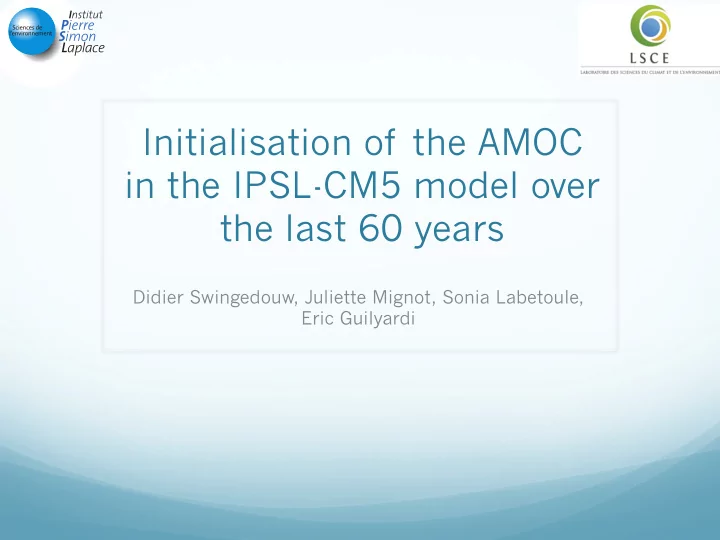

Initialisation of the AMOC in the IPSL-CM5 model over the last 60 years Didier Swingedouw, Juliette Mignot, Sonia Labetoule, Eric Guilyardi
What do we expect from initialisation? Climatic index Observations Model free Model initialised Time Assumptions: 1. Climatic oscillations correctly represented in model (frequency, amplitude)? 2. There exist ways to phase the two signals using coupled models?
AMOC in recent years Latif et al. 2006: NAO NAO and AMOC indexes forces the AMOC through (Latif et al. 2006) heat flux in the Labrador Sea NAO Keenlyside et al. 2008: AMOC (SST initialisation through SST dipole) anomalies allow to capture this mechanism Other mechanisms in the North Atlantic? Salinity?
Tool: IPSL-CM5 coupled model Mixed layer depth in JFM Low resolution version of the model Ocean: NEMO-ORCA2 (149x182xL31) Atmosphere: LMDz (96x96xL39) Sea ice: Lim2 Biogeochemistry in the ocean: PISCES Important biases to be kept in mind Only 10 Sv of AMOC Almost no convection in the Labrador Sea
Decadal variability in the IPSL-CM5 model 500 year AMOC max (preind. simulation) 20-year cycle for the AMOC Impact on the ocean heat transport at different latitudes in the Atlantic Ocean Cross-correlation with AMOC max. AMOC leads Escudier et al. in prep.
20-yr cycle mechanisms Escudier et al. in prep.
20-yr cycle mechanisms
20-yr cycle mechanisms
20-yr cycle mechanisms
20-yr cycle mechanisms Low
20-yr cycle mechanisms Low
20-yr cycle mechanisms
Agreement with GSAs anomalies?
DJF SST in GIN Seas (HadISST) A 20-yr cycle in the subpolar gyre? Very few data on this time scale (for AMOC, SSS) First clue: 20-yr variability in the GIN Seas in HadISST We assume that this cycle is not totally unrealisitic in the real ocean Step 2: can we phase observed and modeled AMOC?
Experimental design We initialise the IPSL-CM5 with SST anomalies (Reynolds) superimposed on each historical simulation over the period 1949-2005: 5-members ensemble (different initial conditions) With one of the initialised members, we launch a 3- members ensemble every 5 years (with white noise on SST) We include historical radiative forcing
(3-yrs running mean) AMOC Obs. (Huck et Reconstruction al. 2008) (Huck et al. 2008) Initialisation Reconstruction of the AMOC using NODC hydrographic Nudged data (Huck et al. 2008) simulations 5-members ensemble of nudged simulations and control-historical ones 5-members historical Historical simulations as control simulations Agreement apart from 1980
Mechanisms SST GIN Sea ice GIN ⇒ GIN seas SST Wind stress ⇒ GIN seas ice cover ⇒ Wind stress EGC ⇒ EGC GSAs! (1970, 82, 90 Lab SSS Sundby & ⇒ SSS Labrador Sea Drinkwater 2007) ⇒ CV sites CV sites ⇒ AMOC AMOC • Labrador Sea SSS = 7-10 years predictor of the AMOC • EGC = more than 10 years predictor
20-yr cycle for the AMOC Nudging in SST
20-yr cycle for the AMOC Nudging in SST
Propagation of 4 3 1 2 SST anomalies Reynolds Nudged sim. Box 1 ⇒ We follow the mininimum of SST along the gyre Box 2 ⇒ 8 years between Labrador and GIN ⇒ True in the model (known) Box 3 ⇒ And in the Reynolds data! Box 4
Air-sea ice interactions in 1979-80 Nudged simulations NCEP SLP DJF 1979 SLP DJF 1979 Sea ice DJF 1979 Sea ice DJF 1979
Hindcasts Only one member of the AMOC 48°N nudged ensemble (planned to apply to each) 3-members ensemble of free run Good predictive skill for the AMOC in perfect model analysis (Persechino et al., in prep.) 90’s max. missed
Hindcasts Only one member of AMOC 48°N the nudged ensemble (planned to apply to each) 3 members ensemble for free run Good predictive skill for the AMOC in perfect model analysis (Persechino et al., in prep.)
Hindcasts AMOC max AMOC 48°N Pac. HT 20°N Atl. HT 20°N
Hindcasts Student 90% test 95% 99%
Conclusions Surprising agreement with data given the biases in the North Atlantic in the IPSL-CM5 model! A different (complementary) story from Latif et al.: an ocean- sea ice-atmosphere coupled mechanism in agreement with GSAs and initialised after 30 years using only Reynolds SST Nevertheless, in the 90s the cooling of the SPG related to high NAO played a role and may explain the very high AMOC max (not captured by free simulations) Correct predictive skill in the North Atlantic and Europe More results in Mignot et al. Poster The problem of sea ice cover: Servonnat et al. talk
Thank you
Why do we miss the 1990s peak?
Why do we miss the 1990s peak
Future Figure T2M global et SST par bassin
Recommend
More recommend